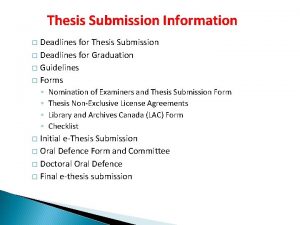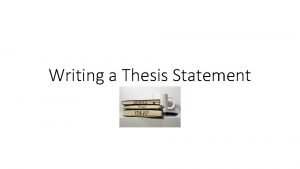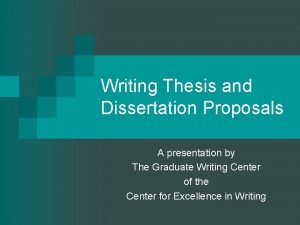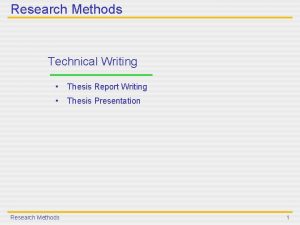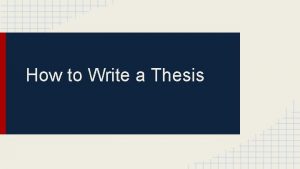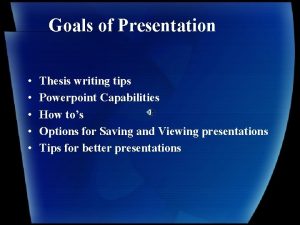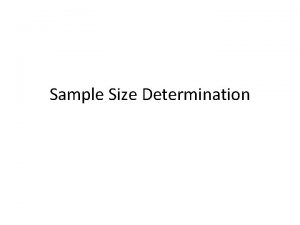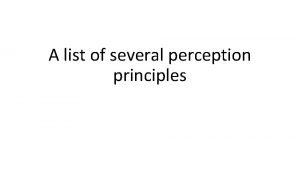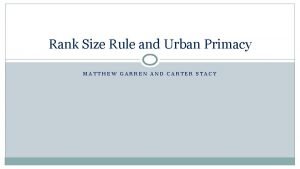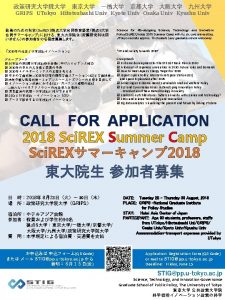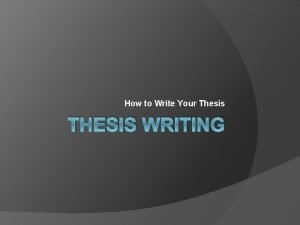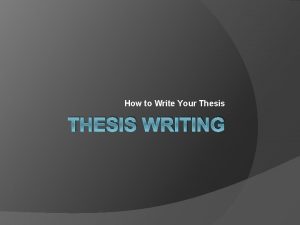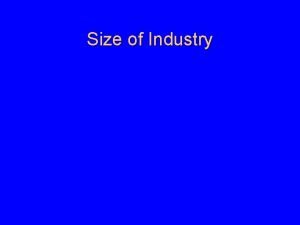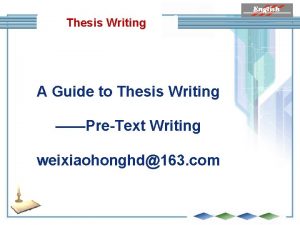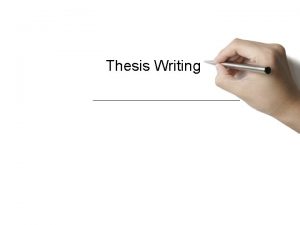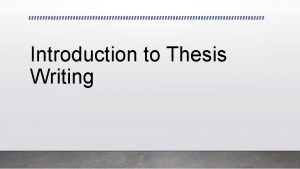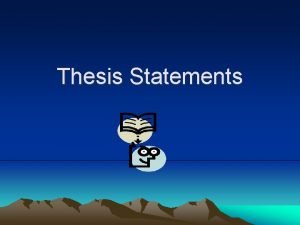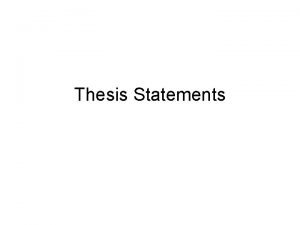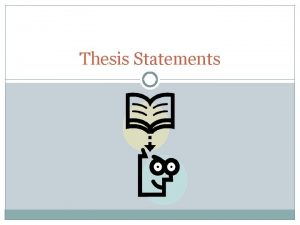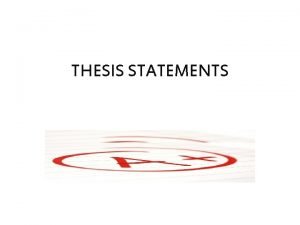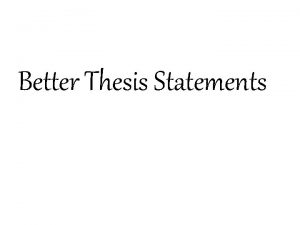Example Writing Thesis HANKYONG NATIONAL UNIV Thesis size




































- Slides: 36

Example Writing Thesis HANKYONG NATIONAL UNIV

Thesis size • Cover page: hardcover, 190 x 260 mm • Internal pages: B 5 (4 x 6) paper, 182 x 257 mm

Contents • • • • Cover page (Outer and Internal) Certificate Abstract (Table of) Contents List of tables, List of figures List of abbreviations Introduction Literature review Materials and methods (Methodology) Results and discussion Conclusion References Summary(Korean) Acknowledgements Appendix

12, bold 16, bold Times New Roman 12, bold


Abstract • • • The abstract should summarize pertinent results in a brief but understandable form. The abstract should start with a clear statement of the objectives of the experiment and must conclude with one or two sentences that highlight important conclusions. References are never cited in the abstract. Abbreviations that appear in the abstract that are not included in the standard abbreviation listing must be defined before they are first used. Abstracts generally do not have citations. Information in title should not be repeated. Be explicit. Use numbers where appropriate. Answers to these questions should be found in the abstract: – – – What did you do? Why did you do it? What question were you trying to answer? How did you do it? State methods. What did you learn? State major results. Why does it matter? Point out at least one significant implication.

Abstract • • • Objectives Methods and materials Results Conclusion Key words

Table of Contents

Table of Contents

List of Tables

List of Figures

List of Abbreviations

Introduction • • • The introduction briefly justifies the research and specifies the hypotheses to be tested. Extensive discussion of relevant literature should be included in the discussion of results, not in the introduction. To minimize length and avoid redundancy, generally no more than three references should be cited to support a specific concept You can't write a good introduction until you know what the body of the paper says. Consider writing the introductory section(s) after you have completed the rest of the paper, rather than before. Be sure to include a hook at the beginning of the introduction. This is a statement of something sufficiently interesting to motivate your reader to read the rest of the paper, it is an important/interesting scientific problem that your paper either solves or addresses. You should draw the reader in and make them want to read the rest of the paper. The next paragraphs in the introduction should cite previous research in this area. It should cite those who had the idea or ideas first, and should also cite those who have done the most recent and relevant work. You should then go on to explain why more work was necessary (your work, of course. )

Introduction What else belongs in the introductory section(s) of your paper? • A statement of the goal of the paper: why the study was undertaken, or why the paper was written. Do not repeat the abstract. • Sufficient background information to allow the reader to understand the context and significance of the question you are trying to address. • Proper acknowledgement of the previous work on which you are building. Sufficient references such that a reader could, by going to the library, achieve a sophisticated understanding of the context and significance of the question. • The introduction should be focused on thesis question(s). All cited work should be directly relevant to the goals of thesis. This is not a place to summarize everything you have ever read on a subject. • Explain the scope of your work, what will and will not be included.

Introduction (Scientific articles) The reason of the study Importance of the study Related previous studies Objectives

Literature review • A literature review is a body of text that aims to review the critical points of current knowledge including substantive findings as well as theoretical and methodological contributions to a particular topic. Literature reviews are secondary sources, and as such, do not report any new or original experimental work. • Its ultimate goal is to bring the reader up to date with current literature on a topic and forms the basis for another goal, such as future research that may be needed in the area. • A well-structured literature review is characterized by a logical flow of ideas; current and relevant references with consistent, appropriate referencing style; proper use of terminology; and an unbiased and comprehensive view of the previous research on the topic.

Materials and Methods (Methodology) Materials and Methods Sections • The methods chapter tells your reader ‘how’ you carried out the research that was needed to answer • your research questions. In the traditional thesis structure it may take up a whole chapter. • Methods sections/chapter functions to explain: - WHEN the study was carried out - WHERE the study was carried out - WHAT materials, techniques, samples, data, approaches, theoretical frameworks were used in the study, and - HOW the study was carried out , or - WHAT procedures were used. • These last two points might include issues such as the statistics that were used to analyse data.

Materials and Methods Methodology (Methodology) • • A design or plan for the study Materials used in the study Methods used in the study Statistical analysis • Key concept: Methods and materials should be clearly explained for others to repeat.

Materials and Methods Methodology (Methodology)

Results and discussion Results • The results are actual statements of observations, including statistics, tables and graphs. • Indicate information on range of variation. • Mention negative results as well as positive. Do not interpret results save that for the discussion. • Present sufficient details so that others can draw their own inferences and construct their own explanations. • Use S. I. units (m, s, kg, W, etc. ) throughout thesis. • Break up your results into logical segments by using subheadings • Key results should be stated in clear sentences at the beginning of paragraphs. It is far better to say "X had significant positive relationship with Y (linear regression p<0. 01, r^2=0. 79)" than to start with a less informative like "There is a significant relationship between X and Y". Describe the nature of the findings; do not just tell the reader whether or not they are significant. • Results may be combined with discussion.

Results and discussion Discussion • Start with a few sentences that summarize the most important results. The discussion section should be a brief essay in itself, answering the following questions and caveats: What are the major patterns in the observations? (Refer to spatial and temporal variations. ) • What are the relationships, trends and generalizations among the results? • What are the exceptions to these patterns or generalizations? • What are the likely causes (mechanisms) underlying these patterns resulting predictions? • Is there agreement or disagreement with previous work? • Interpret results in terms of background laid out in the introduction - what is the relationship of the present results to the original question?

Results and discussion • What is the implication of the present results for other unanswered questions in earth sciences, ecology, environmental policy, etc. . ? • Multiple hypotheses: There are usually several possible explanations for results. Be careful to consider all of these rather than simply pushing your favorite one. If you can eliminate all but one, that is great, but often that is not possible with the data in hand. In that case you should give even treatment to the remaining possibilities, and try to indicate ways in which future work may lead to their discrimination. • Avoid bandwagons: A special case of the above. Avoid jumping a currently fashionable point of view unless your results really do strongly support them. • What are things we now know or understand that we didn't know or understand before the present work? • Include the evidence or line of reasoning supporting each interpretation. • What is the significance of the present results: why should we care?

Results and discussion Tables and figures should be independent on the text. Avoid values already mentioned in tables

Results and discussion Discussion Justify your results with other evidences

Conclusion • What is the strongest and most important statement that you can make from your observations? • If you met the reader at a meeting six months from now, what do you want them to remember about your paper? • Refer back to problem posed, and describe the conclusions that you reached from carrying out this investigation, summarize new observations, new interpretations, and new insights that have resulted from the present work. • Include the broader implications of your results. • Do not repeat word for word the abstract, introduction or discussion.

References • • cite all ideas, concepts, text, data that are not your own if you make a statement, back it up with your own data or a reference all references cited in the text must be listed cite single-author references by the surname of the author (followed by date of the publication in parenthesis) –. . . according to Hays (1994) –. . . population growth is one of the greatest environmental concerns facing future generations (Hays, 1994). • cite double-author references by the surnames of both authors (followed by date of the publication in parenthesis) – e. g. Simpson and Hays (1994) • cite more than double-author references by the surname of the first author followed by et al. and then the date of the publication – e. g. Pfirman, Simpson and Hays (1994) would be: – Pfirman et al. (1994) • do not use footnotes

References list all references cited in the text in alphabetical order and then further sorted chronologically if necessary. More than one reference from the same author(s) in the same year must be identified by the letters “a”, “b”, “c”, etc. , placed after the year of publication. The following format for different types of material: Hinton, E. , and Owen, D. R. J. , Finite Element Programming, Academic Press, London, 1977. (book) Cranwell, P. D. and Moughan, P. J. , Biological limitations imposed by the digestive system to the growth performance of weaned pigs. In: Manipulation Pig Production II (Ed. Barnett, J. L. and Hennessy, D. P. ). Australasian Pig Science Association. Werribee, Australia, pp. 140 -159, 1989. (Chapter in an edited book) Dela, B. , "Shrinkage cracking in high strength concrete, " Master Thesis, Technical Univ. of Denmark, 1994. (thesis) Galambos, J. M. , and Ketter, R. L. , "Columns under combined bending and thrust, " J. Eng. Mech. , 85(2), pp. 1 -30, 1959. (Journals) Galambos, J. M. , and Ketter, R. L. , "Comlumns under combined bending and thrust, " Proceedings on ASCE, pp. 1 -30, Sydney, Australia, 1959. (Conference proceedings) Kim, S. E. , and Chen, W F. , "Practical advanced analysis for braced steel frame design, " Structural Engineering Report, No. CE-STR-95 -11, School of Civil Engineering, Purdue Univ. , West Lafayette, Indiana, 36 pp, 1995. (Technical reports) • Web references: As a minimum, the full URL should be given and the date when the reference was last accessed. Any further information, if known (DOI, author names, dates, reference to a source publication, etc. ), should also be give. Web references can be listed separately (e. g. , after the reference list) under a different heading if desired, or can be included in the reference list. •

Acknowledgements • Advisor(s) and anyone who helped you: technically (including materials, supplies) • intellectually (assistance, advice) • financially (for example, departmental support, travel grants)

Acknowledgements

Appendix • Include all your data in the appendix. • Reference data/materials not easily available (theses are used as a resource by the department and other students). • Tables (where more than 1 -2 pages). • Calculations (where more than 1 -2 pages). • You may include a key article as appendix. • If you consulted a large number of references but did not cite all of them, you might want to include a list of additional resource material, etc. • List of equipment used for an experiment or details of complicated procedures. • Note: Figures and tables, including captions, should be embedded in the text and not in an appendix, unless they are more than 1 -2 pages and are not critical to your argument.

Tables • • Tables are used to present numerical data in a self-explanatory manner. They should be intelligible without consulting the text and should not duplicate data already given in the text or in illustrations. Any abbreviation used in a table must be defined in that table. Tables should be typed doublespaced with each table All tables should be cited in the text. Arabic numerals are used to number tables. The table number (i. e. Table 4. ) is typed in bold face followed by a period. The title of the table continues on the same line with only the first letter capitalized. Do not use a period at the end of the title. Column headings should have the first letter of each word capitalized while the names of variables are typed with only the first letter capitalized (i. e. Average daily gain). For numerals less than 1, insert a zero to the left of the decimal point (columns should be set up so that decimal points are aligned if possible). If there are no data for a particular entry, insert a dash. If an explanation is necessary, use an abbreviation in the body of the table (e. g. ND) and explain clearly in footnotes what the abbreviation means. Care should be taken to ensure that greater accuracy is not implied in the table than is possible from a particular analysis and only significant figures should be used. It is exceedingly rare where accuracy greater than two decimal places is obtained. References to footnotes in a table are specified by superscript numbers, independently for each table. Superscript letters are used to designate statistical significance. Use a lower case p to indicate probability values (i. e. p<0. 05). Presentation of pooled standard errors, the general basis for statistical comparisons of means is recommended when variance is homogenenous. These should be presented in a separate column or row. Standard errors can be attached to each mean by ± signs when variance or SE are heterogeneous (e. g. unbalanced experiments or unequal numbers of observations in treatment means). The pooled standard error is the preferred estimate of experimental error because presenting individual standard errors tends to clutter up the table.

Figure captions • Ensure that each illustration has a caption. A caption should comprise a brief title and a description of the illustration. Keep text in the illustrations themselves to a minimum but explain all symbols and abbreviations used.

The layout of thesis • HKNU thesis form for Master degree Margin Top Left Margin for binding Vertical paper direction Bottom Right Left position

• HKNU thesis form for Master degree Paper size: B 5

• HKNU thesis form for Master degree Head note Foot note

• HKNU thesis form for Master degree
 Jaehoon yu
Jaehoon yu Université constantine 3 médecine
Université constantine 3 médecine Ch rahmoune
Ch rahmoune Sug grant
Sug grant Umbb inim
Umbb inim Organigramme de la pharmacie
Organigramme de la pharmacie Fs.univ.umbb
Fs.univ.umbb Univ constantine 3
Univ constantine 3 Pharmacie univ batna 2
Pharmacie univ batna 2 Scolarité médecine nantes
Scolarité médecine nantes Univ bayadh
Univ bayadh Prodoc univ nantes
Prodoc univ nantes Univ prof titel
Univ prof titel Moodle ustv
Moodle ustv Mail univ ouargla
Mail univ ouargla Sfa univ poitiers
Sfa univ poitiers (univ. caxias do sul) escolha a alternativa que completa
(univ. caxias do sul) escolha a alternativa que completa Lon-capa ohio university
Lon-capa ohio university Univ valenciennes ent
Univ valenciennes ent Ordicentre
Ordicentre Snv mentouri
Snv mentouri Conf univ dr
Conf univ dr![Const int size=18; string *tbl2 = new string[size]; Const int size=18; string *tbl2 = new string[size];](data:image/svg+xml,%3Csvg%20xmlns=%22http://www.w3.org/2000/svg%22%20viewBox=%220%200%20200%20200%22%3E%3C/svg%3E) Const int size=18; string *tbl2 = new string[size];
Const int size=18; string *tbl2 = new string[size]; Size separation example
Size separation example Impersonal tone in writing
Impersonal tone in writing Preface in thesis
Preface in thesis National unification and the national state
National unification and the national state Open vs closed thesis statement
Open vs closed thesis statement Title of the study
Title of the study Research methods and technical writing
Research methods and technical writing Thesis statement
Thesis statement Restating thesis examples
Restating thesis examples Writing a thesis statement powerpoint
Writing a thesis statement powerpoint Formula for sample size
Formula for sample size Relative size perception
Relative size perception Why does the rank size rule not apply in all countries
Why does the rank size rule not apply in all countries Rank size rule formula
Rank size rule formula
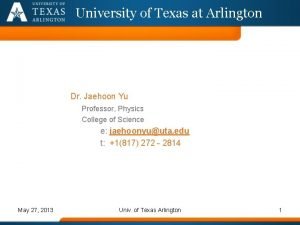

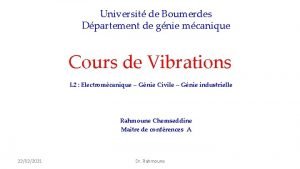
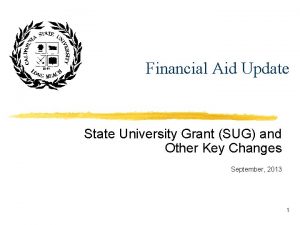
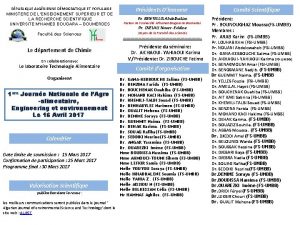
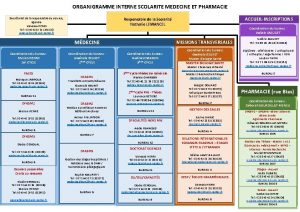
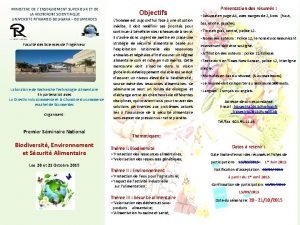
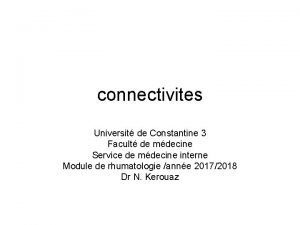
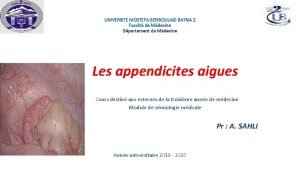
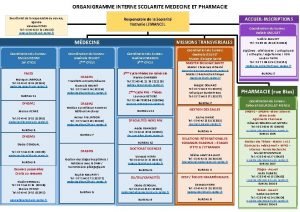
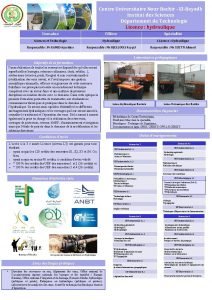
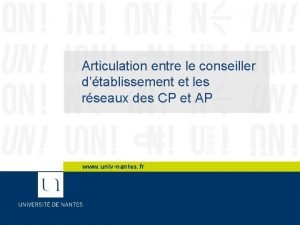

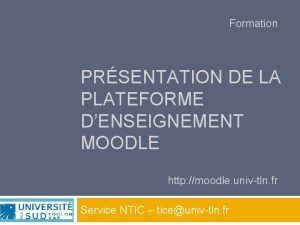
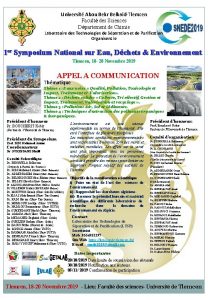


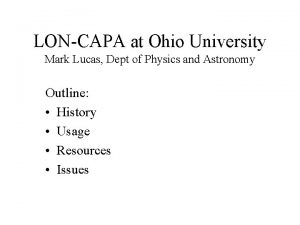
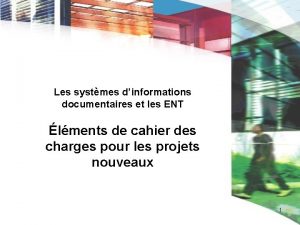

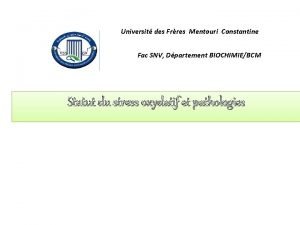
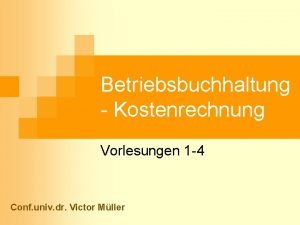
![Const int size=18; string *tbl2 = new string[size]; Const int size=18; string *tbl2 = new string[size];](https://slidetodoc.com/wp-content/uploads/2020/11/1588947_40cf3415d0afabae1c436a49b39f4ad0-300x225.jpg)


